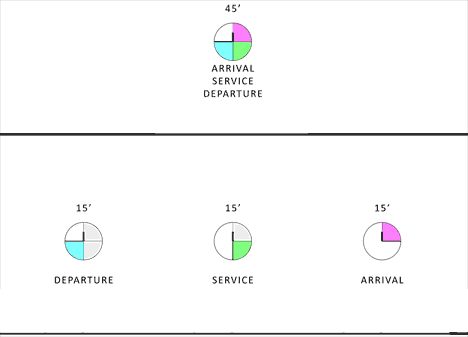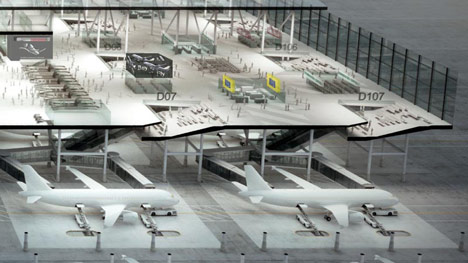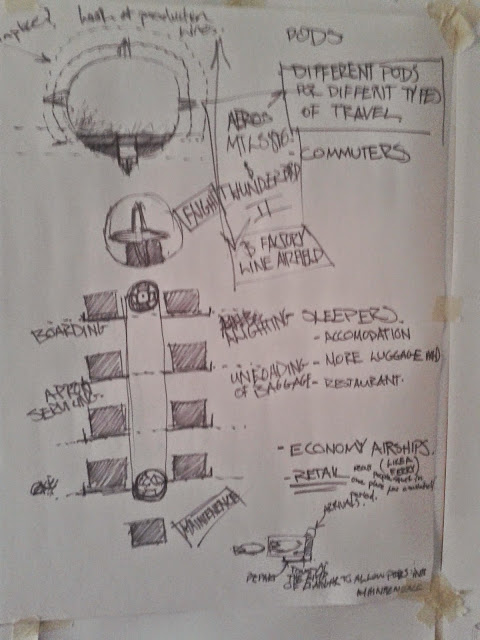Hi Sam,
Apologies for not attending my tutorial on Thursday, I wasn't going to come in at all until I saw Tom's e-mail regarding technical tutorials and I felt no matter how ill I was I couldn't miss one of only two environmental tutorials we have this year, so I just bit the bullet and came in and then went straight home.
Massing
First thing, I finished off my massing diagram sheet:
 |
| Massing Diagram of Initial Proposal |
This is a three dimensional representation of my initial massing sketches which have developed from my feasibility, this has then been exploded to show each individual element of the design and its approximate size in sqm at this stage, which has been tweaked based upon the typical numbers calculated. In the bottom right is an un-exploded model which showing the massed proposal as a whole, showing how the departures terminal, docking tower and arrivals terminal wrap around the south east corner of the hangar.
Layout
********IMAGE OF 1:200 PLAN WITH SKETCHES UP ON THE WALL********
At the stage where I felt the space had been broken down enough I took this into CAD and have continued to work upon the specifics of the layout using both sketching at 1:200 and CAD in tandem. Once I am happy with the solution I move onto the stage of the linear approach to processing the passengers.
 |
| CAD plan in development, the 'Check-in' area (bottom left) has been developed further than the 'Waiting and Retail' area (bottom right) |
One precedent I have been thinking about a lot at the moment is the Eurostar terminal at St Pancras, which from my recollection is a very simple, pleasant and efficient terminal in my experience; which from what I can see should have the capacity to deal with a similar but higher passenger count than my proposed Airship Terminal (Airship Terminal = 12,500, Eurostar = approx 30 trains a day with 600 passengers makes a max load of 18,000 passengers a day.) I suppose although it is not particularly architecturally outstanding, my experience of the efficiency and ease of travel is something I am keen to emulate, this may be down the extremely short travel distances involved and similar to my idea for the pods has one combined 'Gate Lounge' for all of the platforms.
Circulation Diagrams
************************ W.I.P***********************
Site Model
This week I have also fully cut a site model which is at 1:2000 @A2 which is currently in a state of assembly, I hope to use this to display a massing model of my proposal and perhaps one further model which highlights the materiality of the different building components.
Structural Strategies
Although I have not had my structural strategies tutorial yet I do have an overall idea for what should inform the material and overall structural strategies. I see this terminal as a kind of flagship project which along with a select few other terminals and retro fitted docking stations would provide the airship with a springboard to become a staple part of the 21st century. With this in mind the building should reflect this, I envisage a kind of airship inspired high-tech. This would make the whole project in program, aesthetic and its engagement with the process through the airship hangar a true celebration of the airship as a mode of transport. With the addition of the nature of embarking and disembarking proposing a method in which the airship can be brought up to date and begin to meet today's demands of a mode of transport.
This 'Airship Inspired High-Tech' would consist of a combination of lightweight frames, translucent skins and tension wires. But all this lightweight structure would need to be grounded into the site by some heavier architectural elements, perhaps the service spines?
Environmental Strategies
As mentioned I had my 'Environmental Strategies' tutorial with Rob Atherton yesterday, we spoke about how the hangar would form a part of my ventilation strategy used as an outlet for cross ventilation as it is a sheltered but otherwise unconditioned space. We also looked at the potential use of the service spines as tool for a night cooling strategy if constructed out of masonry, which was my initial notion, based upon the aesthetics mentioned earlier.
We also talked about solar strategies but he seemed happy with the way the current design was progressing naturally with regards to this, with the overhanging roof and stepped nature of the southern facade. Rob also mentioned that the arrivals terminal may suffer from low sunlight in the morning as it is facing east, an although that is not too much of a problem it may be something worth taking into consideration in future.
As mentioned I had my 'Environmental Strategies' tutorial with Rob Atherton yesterday, we spoke about how the hangar would form a part of my ventilation strategy used as an outlet for cross ventilation as it is a sheltered but otherwise unconditioned space. We also looked at the potential use of the service spines as tool for a night cooling strategy if constructed out of masonry, which was my initial notion, based upon the aesthetics mentioned earlier.
We also talked about solar strategies but he seemed happy with the way the current design was progressing naturally with regards to this, with the overhanging roof and stepped nature of the southern facade. Rob also mentioned that the arrivals terminal may suffer from low sunlight in the morning as it is facing east, an although that is not too much of a problem it may be something worth taking into consideration in future.
Board Layout
With all of the above in mind I have created a board layout which I will try my best to produce for next week.
Couple of notes: the two 1:200 plans are one plan of the whole building at terminal level perhaps with the ground level kerbside elements on tracing paper to place over the top? The environmental and structural precedent pages would provide simple sections of key parts of the building with the relevant structural and environmental strategies noted upon them.
I think that's it.
Andrew
Couple of notes: the two 1:200 plans are one plan of the whole building at terminal level perhaps with the ground level kerbside elements on tracing paper to place over the top? The environmental and structural precedent pages would provide simple sections of key parts of the building with the relevant structural and environmental strategies noted upon them.
I think that's it.
Andrew
















